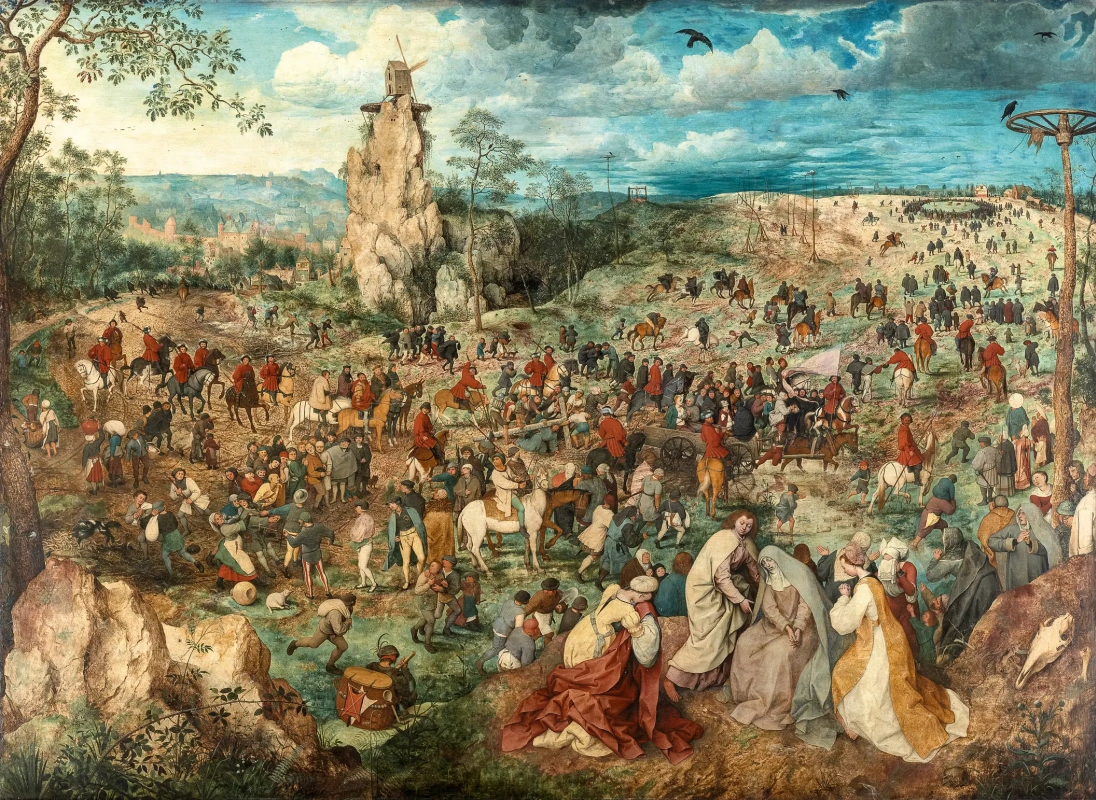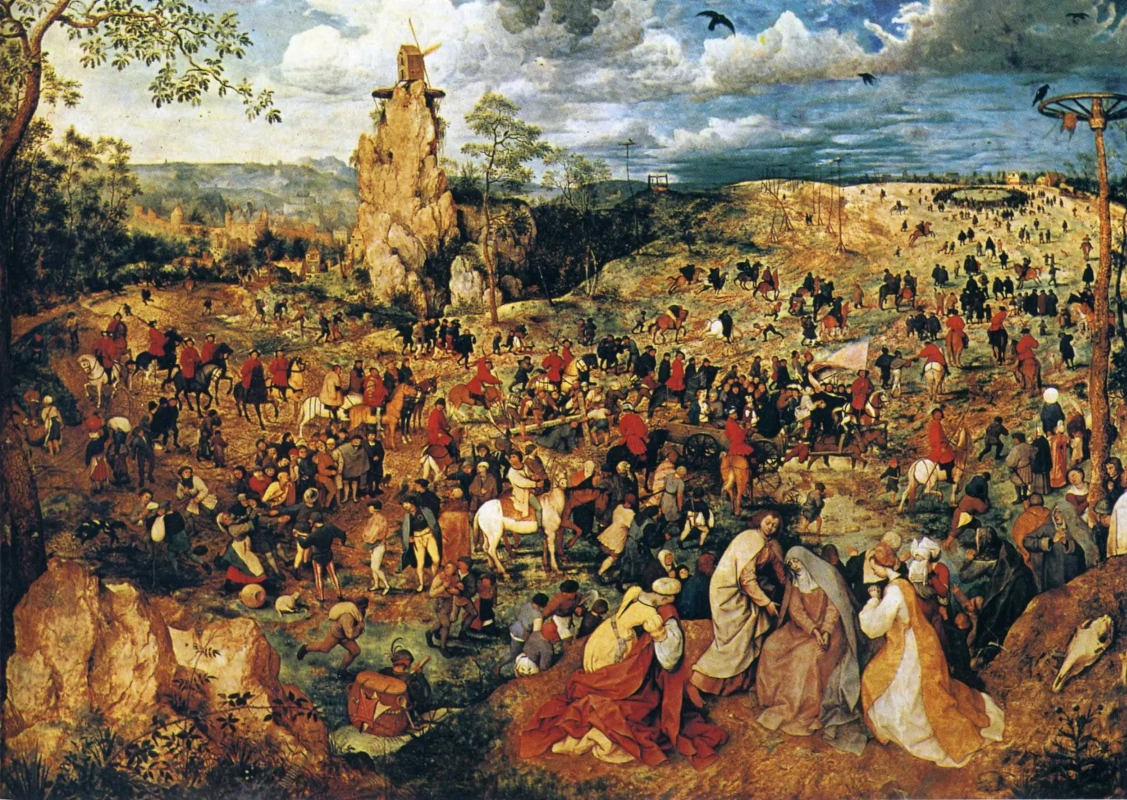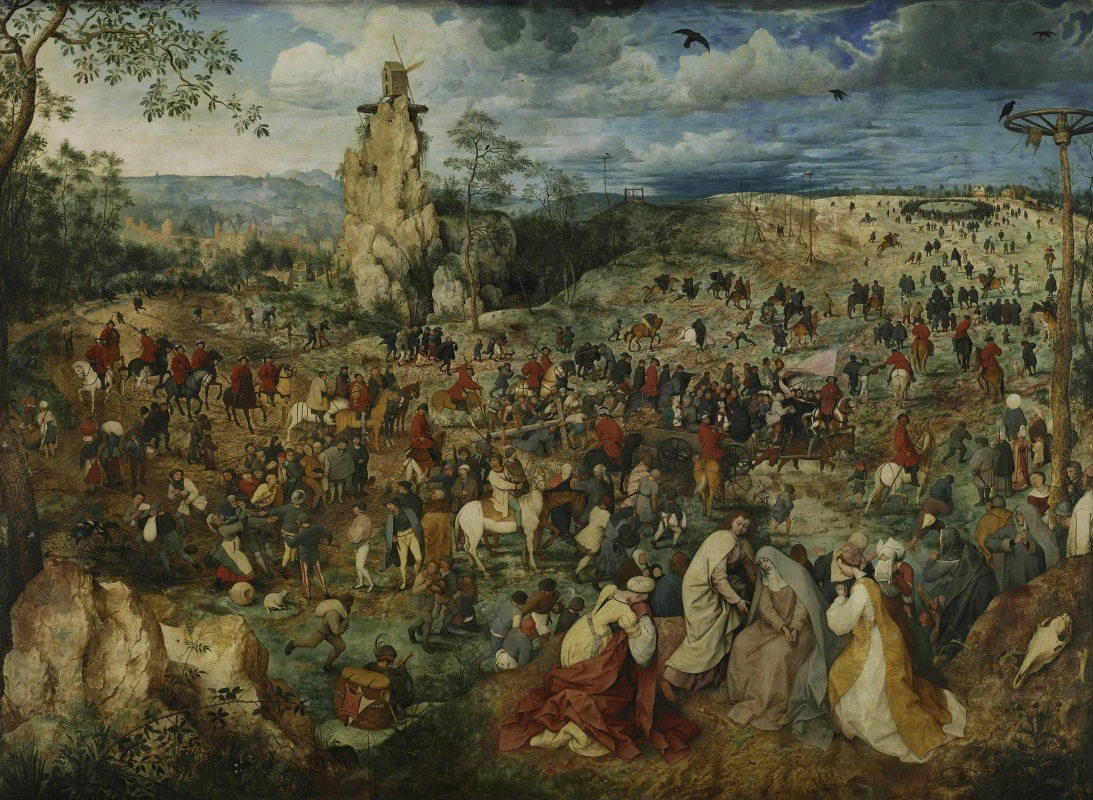log in
Enter site
Login to use Arthive functionality to the maximum
Christ Carrying the Cross
Pieter Bruegel The Elder • Painting, 1564, 124×170 cm


















Description of the artwork «Christ Carrying the Cross»
Painting By Bruegel "Christ Carrying the cross" (another name for "Procession to Calvary") is dedicated to the gospel chapters, where Christ himself carries a heavy wooden cross on which was crucified on Calvary.
But do we see Christ when you first look at the painting by Bruegel? No! Our eyes glide over a huge motley crowd and then stop at the huddled figure of the virgin Mary near or at unusually a high rock crowned with the mill in the distance.
"Carrying the cross" Brueghel's so impressive and mysterious that in 2011 alone, the interpretation of this picture cinematographers devoted to feature film "the Mill and the cross" ((Mlyn i krzyz, dir. Lech Majewski). The role of the artist performed the Rutger Hauer Mary Charlotte Rampling. Of course, interpreting what is depicted, the authors of the film managed to tell a lot about Flanders, and about the Bruegel and the time in which he lived.
So, at first we do not fix the gaze of Christ, but we see scattered across a wide valley crowds of people. Hiking in black, brown and gray clothes look like a modern Brueghel Dutch burghers and peasants. Horsemen in red tunics is hated by the entire population of the Netherlands by the Spanish conquerors. They came to the land of Flanders, to fire and sword to eradicate infiltrated into the country Protestantism and the name of the Spanish king to re-impose Catholicism. High wooden pillar on the right with wheel on top – the instrument of torture. The victim, the suspect in the preaching of the Protestant doctrines, at first severely beaten and then tied to a wheel, raised on a pillar and so left to die. Scraps of clothing and a Raven is a scavenger, depicted by Bruegel, show that the bloody sacrifice was made recently.
In the mouth of Bruegel in the film invested a monologue explaining the meaning of "carrying the cross":
– My picture will tell you many stories. It will be huge and will accommodate everything. I will work like the spider seen in the morning. I watched as it weaves its web. First the spider finds an anchoring point. Here! (points to intersection point of the diagonals of the picture – ed.) In the center of my "web" is millstones grind of our Lord ruthlessly, like grain. I'll show you how it leads to Calvary. He is in the center of the picture, and yet I must hide it from sight.
But why do you hide it?
– Because in it lies the essence, but you probably didn't notice it. And no one notices. Next to Simon is taken away from Esther and all eyes are on him. It always happens: the birth of Jesusor the fall of Icarusor the suicide of Saul– all these world-changing events go unnoticed!
This is the art philosophy Bruegel: we do not always notice important. Too much distracts our attention from the only important. But everything that exists (even irrelevant) for some reason you need God. And the artist also needs to display.
– On most of the paintings depict God in the clouds. He looks down with shame – he finished his monologue Bruegel. – In my painting its placethe Miller will take(this is why the mill – not least the center of gravity of the cross – ed.). He is the Great Miller of heaven, grinding the flour of life and destiny.
Author: Anna Yesterday
But do we see Christ when you first look at the painting by Bruegel? No! Our eyes glide over a huge motley crowd and then stop at the huddled figure of the virgin Mary near or at unusually a high rock crowned with the mill in the distance.
"Carrying the cross" Brueghel's so impressive and mysterious that in 2011 alone, the interpretation of this picture cinematographers devoted to feature film "the Mill and the cross" ((Mlyn i krzyz, dir. Lech Majewski). The role of the artist performed the Rutger Hauer Mary Charlotte Rampling. Of course, interpreting what is depicted, the authors of the film managed to tell a lot about Flanders, and about the Bruegel and the time in which he lived.
So, at first we do not fix the gaze of Christ, but we see scattered across a wide valley crowds of people. Hiking in black, brown and gray clothes look like a modern Brueghel Dutch burghers and peasants. Horsemen in red tunics is hated by the entire population of the Netherlands by the Spanish conquerors. They came to the land of Flanders, to fire and sword to eradicate infiltrated into the country Protestantism and the name of the Spanish king to re-impose Catholicism. High wooden pillar on the right with wheel on top – the instrument of torture. The victim, the suspect in the preaching of the Protestant doctrines, at first severely beaten and then tied to a wheel, raised on a pillar and so left to die. Scraps of clothing and a Raven is a scavenger, depicted by Bruegel, show that the bloody sacrifice was made recently.
In the mouth of Bruegel in the film invested a monologue explaining the meaning of "carrying the cross":
– My picture will tell you many stories. It will be huge and will accommodate everything. I will work like the spider seen in the morning. I watched as it weaves its web. First the spider finds an anchoring point. Here! (points to intersection point of the diagonals of the picture – ed.) In the center of my "web" is millstones grind of our Lord ruthlessly, like grain. I'll show you how it leads to Calvary. He is in the center of the picture, and yet I must hide it from sight.
But why do you hide it?
– Because in it lies the essence, but you probably didn't notice it. And no one notices. Next to Simon is taken away from Esther and all eyes are on him. It always happens: the birth of Jesusor the fall of Icarusor the suicide of Saul– all these world-changing events go unnoticed!
This is the art philosophy Bruegel: we do not always notice important. Too much distracts our attention from the only important. But everything that exists (even irrelevant) for some reason you need God. And the artist also needs to display.
– On most of the paintings depict God in the clouds. He looks down with shame – he finished his monologue Bruegel. – In my painting its placethe Miller will take(this is why the mill – not least the center of gravity of the cross – ed.). He is the Great Miller of heaven, grinding the flour of life and destiny.
Author: Anna Yesterday
Publications about the artwork






